Ryan Hall's Blog, page 329
October 30, 2015
Photos: 2015 New York City Marathon T-Shirts We Love
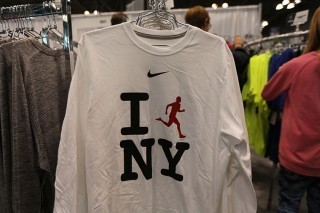
The New York City Marathon Expo in Manhattan is a chance for brands to show off their latest gear and apparel—and that includes T-shirts specifically designed for the New York City Marathon.
RELATED: Photos: Inside the New York City Marathon Expo
Here are some of our favorites (all photos by Steve Godwin and Brian Metzler):
Photo Gallery
1 of {count}
Back to Start
View Larger Image

From Saucony
View Larger Image

From New Balance
View Larger Image

From ASICS
View Larger Image

IMG_0325
From The North Face
View Larger Image

From Nike
View Larger Image
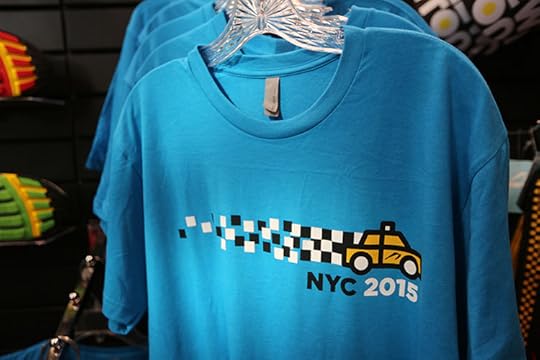
From Newton
View Larger Image

From Skechers
View Larger Image

From Brooks
View Larger Image

From ASICS
View Larger Image

From NYPD Running Club
View Larger Image

From New Balance
View Larger Image

From Skechers
View Larger Image

From New Balance
View Larger Image

From adidas
View Larger Image

From ASICS
View Larger Image

From ASICS
View Larger Image

From The North Face
View Larger Image

From Skechers
View Larger Image

From New Balance.
View Larger Image
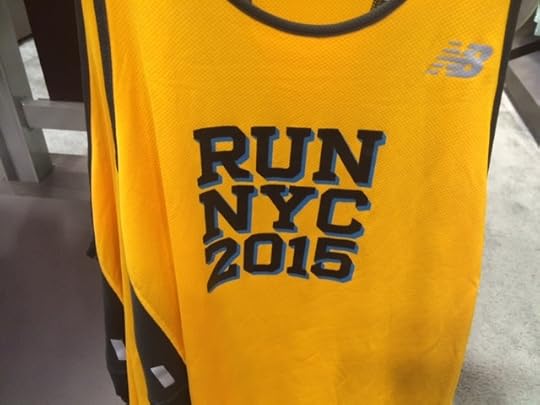
From New Balance
View Larger Image

From The North Face.
View Larger Image

The participant T-shirt, from ASICS.
View Larger Image

From New Balance
View Larger Image

From The North Face
Related Galleries
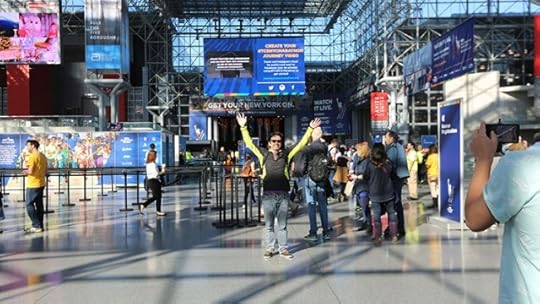
Photos: Inside the New York City Marathon Expo
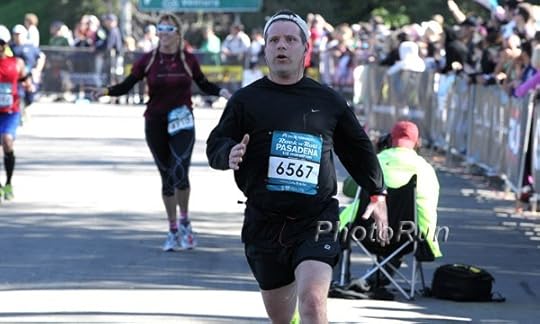
Celebrities Running the 2015 New York City Marathon
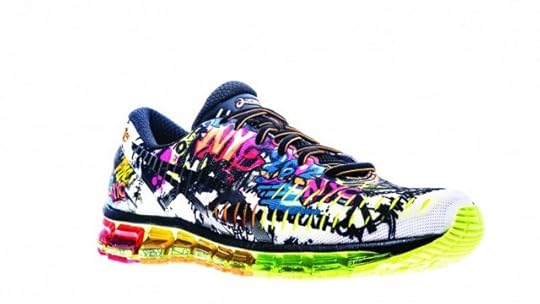
Sneak Peek: Special-Edition Shoes for the 2015 New York City Marathon

More Galleries
The post Photos: 2015 New York City Marathon T-Shirts We Love appeared first on Competitor.com.
Photos: New York City Marathon T-Shirts We Love

The New York City Marathon Expo in Manhattan is a chance for brands to show off their latest gear and apparel—and that includes shirts specifically designed for the New York City Marathon.
RELATED: Photos: Inside the New York City Marathon Expo
Here are some of our favorites (all photos by Steve Godwin and Brian Metzler):
Photo Gallery
1 of {count}
Back to Start
View Larger Image

From Saucony
View Larger Image

From Nike.
View Larger Image

From ASICS.
View Larger Image

IMG_0325
From The North Face.
View Larger Image

From Nike.
View Larger Image

From Newton.
View Larger Image

View Larger Image

From Brooks.
View Larger Image

From ASICS.
View Larger Image

View Larger Image

From New Balance
View Larger Image

From Skechers
View Larger Image

View Larger Image

From adidas.
View Larger Image

View Larger Image

View Larger Image

View Larger Image

From Skechers
View Larger Image

From New Balance.
View Larger Image

From New Balance
View Larger Image

From The North Face.
View Larger Image

The participant T-shirt, from ASICS.
View Larger Image

View Larger Image

Related Galleries

Photos: Inside the New York City Marathon Expo

Celebrities Running the 2015 New York City Marathon

Sneak Peek: Special-Edition Shoes for the 2015 New York City Marathon

More Galleries
The post Photos: New York City Marathon T-Shirts We Love appeared first on Competitor.com.
Jelena Prokopcuka Back in New York, Where She Has Thrived for Years
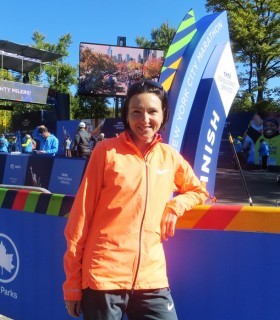
Photo: Chris Lotsbom/Race Results Weekly
(c) 2015 Race Results Weekly, all rights reserved. Used with permission.
NEW YORK — Latvia’s Jelena Prokopcuka has won two New York City Marathon titles, placed on the podium at two more, and finished in the top five in all six of her five-borough jaunts. With that said, there’s no question why this is Prokopcuka’s favorite marathon.
“This is my marathon!” Prokopcuka proclaimed with a smile, speaking exclusively to Race Results Weekly at the race’s press center. Flanked by her husband Aleks, Prokopcuka sported a pink Nike track suit and an enthusiastic grin, anxiously awaiting Sunday’s race.
At the age of 39, Prokopcuka is the most experienced athlete in the women’s elite field. With at least 19 marathons under her belt, she’s long been a fixture on the road racing scene. Yet there’s something extra special in store whenever Prokopcuka returns to the Big Apple.
It all began more than a decade ago in 2004, when Prokopcuka came to New York City for the first time. Without a moment’s hesitation she recalls the date, her race, fifth-place finish, and the revelation that hit her that day.
“My first run in New York was in 2004 and I didn’t expect something special. It was a very interesting experience, as 2004 was a lot of, as usual, strong runners,” she said, emphasizing with her hands how strong the field was [it included world record holder Paula Radcliffe]. “And I was fifth position, yes? I was disappointed because at that moment I understood I could run faster. But my coach and everyone were so happy because I was five. Of course five is great, but at that point I was disappointed.”
Though disappointed she couldn’t grab a podium spot, the moment gave Prokopcuka confidence and the drive that she could truly compete and contend with top women from around the world. A year later she returned here and took home victory, winning over Susan Chepkemei and Derartu Tulu.
“I like New York, yes,” she began, reflecting on her first title. “I won twice in New York, so of course it is something special for me. But it was my first marathon that I get a crown. It was amazing. I like this place, I like these people, I like the amazing atmosphere.”
In love with this throbbing city of over eight million, Prokopcuka successfully retained her title in 2006, finishing ahead of Catherine Ndereba and Deena Kastor, among others. A grind-it-out, foot-on-the-gas-pedal runner, Prokopcuka thrived on the undulating course and its spirit-breaking hills. “This course is very suitable for me because it is not flat. It is a difficult course, and I can use this very well and because it is difficult, it is my course.”
My course. Prokopcuka points to her heart when she calls New York ‘My Course.’ Placing third in 2007 and 2013, then fourth last year, Prokopcuka keeps racking up stellar finishes. Like Meb Keflezighi on the men’s side, she’s an ageless wonder, competing side-by-side with women years younger (Prokopcuka turned 39 in September).
“[In 2014] I did what I could and was able to do. I was happy to be fourth, because fourth at the New York Marathon is great. To be first is unbelievable, yes. To be third is amazing. To win is very good. I understand I am not so young and it’s very different to struggle with the youngest runners, so I am happy with all my places. Of course I want to win but now, it’s not so,” she began before a long, drawn out pause. Speaking from the heart, she chooses her words carefully. “Not so important. I just like to run and am very happy what I can run now. Of course it is more difficult than ten years ago, but anyway I am here, I am invited and I have a chance to run and win in the first five positions. I am happy.”
While defending champion Mary Keitany, London Marathon winner Tigist Tufa, Boston Marathon victor Caroline Rotich, and Olympic silver medalist and 2013 TCS New York City Marathon champion Priscah Jeptoo have gained a majority of the pre-race headlines, Prokopcuka must still be considered a top contender. Her resume is deeper than the rest, and her experience on the course is unmatched.
“I feel I am strong and I respect my competitors. But I feel I can run [fast], so it’s an amazing feeling when you understand that you are not young, not so long way in the future [in terms of years left in her career], but you are here and you win respect. It is great,” she said. “I know this course very well, I can use this course, and I think this course likes me, too! It helps me, too!”
When asked her goal for Sunday, Prokopcuka looks out towards the finish line area, adjusts her signature dark sunglasses perched atop her head, and then answers. She spent three weeks in St. Moritz at altitude, and thinks back to the hard runs tuning up for her return to Manhattan.
“[New York] gives me a lot of energy and it is great. I am going to do the best I can,” she began, speaking in an endearing accent. “My ideal race is if I can do the best I can. Now it is difficult to speak about time or position, yes, but I did a lot [of training] and feel I am strong enough to run well. I have a chance! And if I am ready I will use this chance.”
The post Jelena Prokopcuka Back in New York, Where She Has Thrived for Years appeared first on Competitor.com.
The Evolution of the Marathon’s Fastest Men
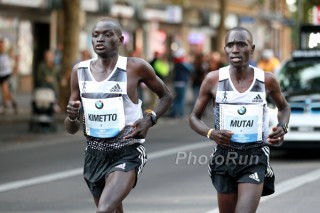
Photo: PhotoRun.net
This is an excerpt from TWO HOURS by Ed Caesar. Copyright © 2015 by Ed Caesar. Reprinted by permission of Simon & Schuster, Inc, NY.
Geoffrey Mutai had no doubt that running 26 miles and 385 yards in less than two hours was physically possible. The performance, he believed, was within his own body. What stopped marathoners from running faster, he believed, was not so much the structure of their bodies as the structure of races. There was no point thinking about the two-hour marathon when you saw how the sport existed in 2012—namely, a few exceptional athletes lined up twice a year in a great world city, barreling 26.2 miles through the streets.
Occasionally, at night in his mountain hideaway, Mutai would fantasize about how the sport might evolve so that it became more about the limits of physiology than about winners and losers. He knew that in the right set of circumstances, people could run so much faster.
For a niche sport like professional marathon running, record times at a Sunday marathon are sometimes the only way to generate a Monday headline. So, between the organizers, the athletes, and Mutai’s manager, a plan was drawn up for the 2012 Berlin Marathon. The pacemakers were to take the lead pack through the halfway mark in 61 minutes and 30 seconds. If all went according to schedule, Mutai would finish the race in an “even” split (for exactly two hours and three minutes), or he would run the second half faster than the first for a “negative” split of 2:02 and change.
To a marathon runner of almost any standard, these numbers are enough to provoke nightmares. For an elite competitor, one’s predicted halfway split time is significant because it is a marker of what one hopes to achieve in the race. The marathon is, at its highest level, a delicate exercise in expending energy evenly over the entire course, and the fastest times are generally achieved when the second half of the race is run at the same speed (an “even” split) as, or slightly faster (a “negative” split) than, the first. Sudden rises or dips in pace can kill a record attempt stone dead. At many marathons, race organizers employ pacemakers, or “rabbits”—other athletes who for reasons of schedule, finance, or talent are paid a few thousand dollars each to run only a limited section of the race—to ensure that the lead athlete’s desired pace is adhered to, and to offer some protection against the wind. The rabbits are generally paid by distance: some will travel to halfway, some to 25km, and the strongest to 30km or 32km. From there, the racers are on their own.
RELATED: A Sub-2-Hour Marathon? It Could Happen Sooner Than You Think
At the prerace technical meeting in a drab conference room at Berlin’s Maritim Hotel, at noon on the day before the marathon, it was confirmed that Mutai had asked the rabbits to take him through halfway in 61:30. No athlete in the history of the sport had ever asked for such a fast split, but the other Kenyans in the room didn’t flinch. At least four of them felt confident that they could run 61:30 for the first half and still finish strong. However, when Jan Fitschen—an affable German marathon runner in the twilight of a career in which he had won, among other honors, the European 10,000m gold medal—was asked about the split Mutai had requested, he made an unfamiliar sound, somewhere between a giggle and a cough. A few minutes later, when the meeting was finished, he walked away shaking his head and laughing. Fitschen hoped to run the first half of the race in 67 minutes.
Ten years earlier, running the first half in 62 minutes and 30 seconds was considered suicidal. When Haile Gebrselassie ran his first marathon in London, in 2002, he asked the pacemakers for this very split—62:30—to widespread amazement. There was a belief that if a runner, even one as talented as Gebrselassie, were to start so fast, he would inevitably “blow up” in the second half of the race as his energy reserves dwindled and lactic acid flooded his muscles. A 62:30 split, it was thought, was a sure and painful way to lose money.
One of Haile’s competitors for the 2002 London Marathon was the world record holder Khalid Khannouchi, who was raised in Morocco and became an American citizen in 2000. When Khannouchi’s wife, Sandra, heard about the split Haile had proposed, she was apparently so incensed that she made a noisy demonstration of her feelings at the prerace technical meeting. There was no way, she said, that her husband would be joining this idiotic early pace. But come halfway, Khannouchi was with Haile and the other challenger, Paul Tergat—and evidently the pace did not finish him off. He went on to win the race and break the world record in 2:05:38.
Strange things had happened to professional marathon running since 2002. Not only had two minutes fallen from the world record, but the distance appeared to have changed genre. By 2012, the elite no longer considered the marathon a pure endurance event. It was a speed-endurance event. The world’s best had, in the words of the American commentator Toni Reavis, “out-trained the distance.” To explain the difference, many of the most experienced coaches used an automotive analogy. It used to be the case that marathon runners needed a diesel engine. Now the best had turbo-diesels. They were capable of both doughty endurance and devastating pace.
This is an excerpt from TWO HOURS by Ed Caesar. Copyright © 2015 by Ed Caesar. Reprinted by permission of Simon & Schuster, Inc, NY.
The post The Evolution of the Marathon’s Fastest Men appeared first on Competitor.com.
The Greatest Running Books: Honorable Mentions Worth Reading
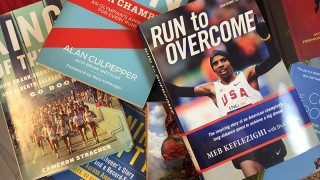
There have been hundreds of great books written about running. Here are a few more that didn’t make our Top 25 list but are still very much worth reading.
RELATED: The 25 Greatest Running Books of All-Time
“Run or Die”
by Kilian Jornet, 2012
“Advanced Marathoning”
by Pete Pfitzinger & Scott Douglas, 2001
“Daniels Running Formula”
by Jack Daniels, Ph.D
“Believe Training Journal”
by Lauren Fleshman and Roisin McGettigan-Dumas, 2014
“Galloway’s Book on Running”
By Jeff Galloway, 1984
“Run Faster from the 5K to the Marathon”
by Brad Hudson and Matt Fitzgerald, 2008
“Running for My Life: One Lost Boy’s Journey from the Killing Fields of Sudan to the Olympic Games”
by Lopez Lomong with Mark Tabb, 2012
“Unbreakable Runner: Unleash the Power of Strength & Conditioning for a Lifetime of Running Strong”
by Brian MacKenzie and TJ Murphy, 2014
“More Fire: How to Run the Kenyan Way”
By Toby Tanser, 2008
“The Pedestriennes: America’s Forgotten Superstars”
by Harry Hall, 2014
“Unbroken: A World War II Story of Survival, Resilience and Redemption”
By Laura Hillebrand, 2010
“You (Only Faster)”
By Greg McMillan, 2013
“Running Wild: An Extraordinary Adventure of the Human Spirit”
by John Annerino, 1997
“Running on Empty: An Ultrarunner’s Story of Love, Loss and a Record-Setting Run Across America”
by Marshall Ulrich, 2011
“Personal Record: A Love Affair with Running”
by Rachel Toor, 2010
“The New Rules of Marathon and Half-Marathon Nutrition: A Cutting-Edge Plan to Fuel Your Body Beyond ‘The Wall’”
By Matt Fitzgerald, 2014
“Ultramarathon Man: Confessions of an All-Night Runner”
By Dean Karnazes, 2005
“A Clear, Cold Day: The Athletic Biography of Buddy Edelen”
by Frank Murphy, 2000
“Kings of the Road: How Frank Shorter, Bill Rodgers and Alberto Salazar Made Running Go Boom”
by Cameron Stracher, 2013
“Marathon Man: My 26.2-Mile Journey from Unknown Grad Student to the Top of the Running World”
by Bill Rodgers, 2013
“Hansons Marathon Method: A Renegade Path to Your Fastest Marathon”
by Luke Humphrey, 2012
“Hal Koerner’s Field Guide to Ultra Running: Training for an Ultramarathon, from 50K to 100 Miles and Beyond”
by Hal Koerner with Adam Chase
“Young At Heart: The Story of Johnny Kelley, Boston’s Marathon Man”
by Frederick Lewis, 2005
“Relentless Forward Progress: A Guide to Running Ultramarathons”
by Bryon Powell, 2011
“Run Like a Champion: An Olympian’s Approach for Every Runner”
by Alan Culpepper, 2015
“The Official Rock ‘n’ Roll Guide to Marathon & Half-Marathon Training,”
by Mario Fraioli, 2013
“Run To Overcome: The Inspiring Story of an American Champion’s Long-Distance Quest to Achieve a Big Dream”
by Meb Keflezighi, 2009
“Running the Lydiard Way”
by Arthur Lydiard and Garth Gilmour, 1978
“Jogging: A Physical Fitness Program for All Ages”
by Bill Bowerman and W.E. Harris, M.D., 1967
“The Science of Running: How to Find Your Limit and Train to Maximize Your Performance”
By Steve Magness, 2014
“Running Ransom Road: Confronting the Past One Marathon at a Time”
by Caleb Daniloff, 2012
“The Runner’s Guide to the Meaning of Life: What 35 Years of Running Has Taught Me About Winning, Losing, Happiness, Humility the the Human Heart”
By Amby Burfoot,
“The Sports Gene: Inside the Science of Extraordinary Athletic Performance”
By David Epstein, 2014
“My Life on The Run: The Wit, Wisdom and Insights of a Road Racing Icon”
by Bart Yasso, 2008
“The Cool Impossible: The Coach from ‘Born to Run’ Shows How to Get the Most FromYour Miles-And From Yourself”
by Eric Orton, 2013
“Build Your Running Body: A Total-Body Fitness Plan for All Distance Runners, from Milers to UltramarathonersRun Farther, Faster, and Injury-Free”
by Pete Magill, 2014
“The Little Red Book of Running”
By Scott Douglas, 2011
“Anatomy For Runners: Unlocking Your Athletic Potential for Health, Speed and Injury Prevention”
by Jay Dicharry, 2012
“Tread Lightly: Form, Footwear, and the Quest for Injury-Free Running”
by Peter Larson and Bill Katovsky, 2012
The post The Greatest Running Books: Honorable Mentions Worth Reading appeared first on Competitor.com.
The 25 Greatest Running Books of All-Time
The post The 25 Greatest Running Books of All-Time appeared first on Competitor.com.
October 29, 2015
10 Fun Facts About Meb’s 10 NYC Marathons
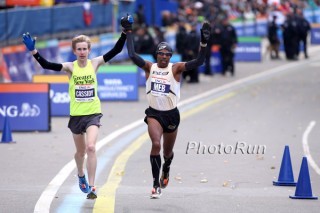
(c) 2015 Race Results Weekly, all rights reserved. Used with permission.
NEW YORK — Meb Keflezighi has always had an extra special spot in his heart for the TCS New York City Marathon. It’s where his marathon career began back in 2002, when he finished ninth and swore never to do another marathon again. And it’s where he shocked many by defeating Robert Kipkoech Cheruiyot and a strong East African field to win the 2009 race, becoming the first American man since Alberto Salazar in 1982 to don the winner’s wreath.
In the last 13 years, Meb’s had podium showings (three of them) and a few struggles (a 20th place in 2006 and a 23rd in 2013). He’s had ups and downs, just like the many bridges and hills that dot the course. Yet he’s always come back for more.
RELATED: Meb Keflezighi Breaks Down the NYC Marathon’s 5-Borough Course
While Meb’s story of triumph through adversity is well chronicled, Race Results Weekly thought we’d dig a little bit deeper to recognize his return to the city. Here are 10 facts—some you may know, others you may not—about Keflezighi’s adventures in New York.
1 . Meb once swore off the marathon.
Back in 2002, when ‘Lose Yourself’ by Eminem was topping the charts and the New York Giants were atop the NFL standings, Meb ran through the five boroughs for the first time. Midway through the race, Keflezighi disregarded coach Bob Larsen’s advice and took the lead on First Avenue. He’d later pay for the aggressive move, running out of energy and finishing a distant ninth in 2:12:35.
“He really suffered in those last few miles… He looked up at me [at the finish] and says, ‘You just saw my first and last marathon,'” recalls Larsen with a chuckle. “I knew it wasn’t his last one.”
Subsequently, Meb took a trip back to his native Eritrea. That’s where the marathon bug bit him again, and he vowed to return to the distance.
“Within a few months he visited Eritrea for the first time since he was a little kid and that really inspired him again,” says Larsen. “When he had to wait [to run his next marathon] I think that was a good thing.”
2. Coach Larsen has been there for it all.
Larsen has been by Keflezighi’s side every single step of the way since his days at UCLA. That includes all 10 New York City Marathons, his Boston Marathon win, and his 2004 Olympic silver medal. When asked by RRW how Meb has changed over the years, Larsen laughs.
“I think the wonderful thing about Meb is that he hasn’t changed, or he has changed very little,” said Larsen. “He still has that feeling that he can run with anybody… That’s where the ‘Run to Win’ [motto] comes from. Not necessarily that he’s going to come in first, but that he is going to get the best out of himself.”
3. Meb was honored in the Thanksgiving Day parade.
After winning the 2009 TCS New York City Marathon, Meb was honored by wearing his gold champion’s medal on a float at the 83rd Macy’s Thanksgiving Day Parade. He was joined by Miss America Katie Stam on the Statue of Liberty float, as well as some of his family members.
Also that year Meb was a guest on ‘Late Night with David Letterman,’ reading the Top 10 list—Top 10 Thoughts That Go Through Your Mind When Running The New York City Marathon.
4. Race weekend is super busy for Meb.
For a majority of the elite field, a trip here means resting and relaxing before the big race. For Meb, it’s the complete opposite. In the 72 hours leading to the start line he’ll make countless appearances at media outings, sponsor arrangements, and more. Keflezighi said he’s working on six hours of sleep over the last two days, thanks to travel, meetings, and more. He took a red-eye flight to get here last night.
“But I love being in New York!” he said. Don’t worry—he’ll be firing on all cylinders come race day.
5. Meb and his wife made it official in New York.
Keflezighi and wife Yordanos Asgedom have an extra special memory in Central Park. One night in May 2005, Meb asked Yordanos to go for a walk with him in the famed park. En route to Central Park, the pair came across a Zales jewelery store.
“It was very nice,” Yordanos began, giggling as she recalled the moment. “He stopped across the street from a Zales jewelry store. He stops, looks at me and makes sure I see it, and then it dawned on me that he was taking me there at that very moment. So we walked across the street and he goes ‘Pick any ring you’d like!’ That’s how it went.
“You know, there’s so many good memories here. So many great memories. That’s just one of many!” she said.
6. Meb would have 11 if not for Hurricane Sandy.
This year’s race would be Meb’s 11th New York City Marathon had Hurricane Sandy not forced the cancellation of the 2012 edition. That year, Keflezighi stood up at an athletes meeting and addressed the crowd of devastated elites. While everyone in attendance was disappointed, Keflezighi looked for a silver lining and put the race in perspective.
“Let’s not look at the one year we missed out, but on how much the New York Road Runners and the city of New York has given us in the past, and will give us in the future,” Keflezighi said in an inspiring tone. “There’s nothing like what the New York Road Runners have done—first class service. And it’s because of the volunteers [that] elite athletes and others can say ‘hey, we want you to have a positive race experience.'”
7. Meb made a grand entrance for number 10.
Meb announced his intention to run this year’s New York City Marathon in a unique way: on national television during the NYRR Fifth Avenue Mile. Appearing on ESPN’s coverage of the race, Keflezighi proudly joined NYRR’s youth Mighty Milers and said he would return to race here for the 10th time.
Along with reigning women’s wheelchair champion Tatyana McFadden, Keflezighi is an ambassador for the NYRR’s Team for Kids youth initiative that gives children the opportunity to run and experience the joys ofrunning.
8. Meb loves the Jay-Z hit ‘Empire State of Mind.’
According to Yordanos and Meb’s brother, Hawi, one of his favorite songs is “Empire State Of Mind” as performed by Jay-Z and Alicia Keys. The 2009 chart-topping hit is a family favorite because it brings back all the special memories shared in the city.
“That song came out right round the time when he won the marathon, so he loves listening to it. It’s extra special,” said Hawi.
9. Meb still loves the challenge.
Coach Larsen shared with RRW that Meb savors facing younger competition, particularly the up-and-coming marathoners of the world. On Sunday, he’ll face former world record holder Wilson Kipsang, as well as this year’s World Championships 10,000m silver medalist Geoffrey Kamworor.
“He always brings his ‘A’ game,” Larsen said. “I think he’s having maybe as much fun as he’s ever had at 40. He may disagree with me because it’s damn hard work. But in some ways he’s enjoying being 40 and putting pressure on the young guys. I think anybody would enjoy that. But it hasn’t changed him a bit. He still wants to be in the Olympics with these guys.”
10. Meb definitely feels the pain.
Meb, like most runners, feels the pain associated with running a marathon. He told media members that after a typical marathon, he’ll be in pain for roughly four days. After all, Meb is mortal!
“I am unable to move until Thursday for sure,” he said. “I jokingly say if you want to know how I feel, have an 80-year-old run on pavement 26.2 miles, 12 miles an hour, and you won’t be able to wake up. But you’ll sleep comfortably for five or six days.”
A true family man, Keflezighi savors time with his family. Here at the race’s media center, some of his closest family members gathered for photos at the dais. They have been by his side from his first steps taken on the Verrazano Bridge, all the way through the Central Park finish line.
“I feel blessed to be here. I am excited for Sunday, my 10th one. It should be fun, should be a lot of work, but I feel ready, and I’ll see what happens,” he said. “That’s what racing is. I always say ‘Run to Win.’ It doesn’t mean getting first place all the time. If you have the courage and honor like I did in 2009 or in Boston, you go for it. But if not, you finish as high as possible and the best that you can because you have the body that is able to do that. And you know what, you will never regret it after you finish and you’ll come back strong.”
The post 10 Fun Facts About Meb’s 10 NYC Marathons appeared first on Competitor.com.
Wilson Kipsang Prepares for Encore at NYC Marathon

New York City Marathon race director Peter Ciaccia with reigning race champion Wilson Kipsang. (Photo: Chris Lotsbom/Race Results Weekly)
(c) 2015 Race Results Weekly, all rights reserved. Used with permission.
NEW YORK — With a sly grin and shift of his eyes, defending TCS New York City Marathon champion Wilson Kipsang sent a warning to his challengers: you better watch out. Speaking here steps from the race’s finish line, the 33-year-old Olympic bronze medalist assured members of the media he is more than ready for Sunday’s 26.2-mile race through the city’s five boroughs.
“I think when I compare my condition from last year to this year, I think this year I am a bit [more] well prepared and I think I can run faster than last year,” said Kipsang, sporting a purple adidas track suit and bright yellow training shoes.
Twelve months ago Kipsang won what resembled more of a boxing match than footrace, exchanging scowls and surges with Ethiopia’s Lelisa Desisa through Central Park. After giving his foe one last chance, Kipsang sprinted away to victory in 2:10:59, securing the race win, Abbott World Marathon Majors crown, and its accompanying title of ‘Marathon King of the World.’ The Majors title was also worth a $500,000 bonus.
His New York City Marathon debut also served as a reconnaissance mission. While running conservatively through the race’s first half, Kipsang soaked up knowledge of the course, atmosphere, and undulating terrain. He knew he’d return in the near future.
“Last year was my first time so I don’t even know how the course would be,” he began. “But this year I know how the course was and I prepare very well training like the course, doing endurance and lots of speed.”
Training in Kenya, Kipsang said he’s primarily worked on up and downhill fartleks. A specialty workout of 10 x 1,000-meter repeats ranging between 2:48 and 2:45 was completed in his buildup, the final indication that he is ready to take the starting line on Sunday.
Kipsang seeks to join John Kagwe as the only Kenyan man to win in consecutive years; Kagwe took home titles in 1997 and 1998 (It should be noted that compatriot Geoffrey Mutai won twice in a row, though his victories were bookends to the race’s cancellation in 2012 due to Hurricane Sandy).
When questioned about an apparent hiccup at this year’s IAAF World Championships Marathon in Beijing, Kipsang scoffed. His DNF was nothing to be concerned about, and was more of a tempo workout.
“It was like a normal long run in Kenya [with surges],” said Kipsang. “It was like I was training all through for this race.” Before, during, and after the World Championships, his eyes were on a return to New York.
Kipsang is an Olympic medalist, has won marathon titles at six cities around the globe (including New York, London, Berlin, and Frankfurt), and is a former world record holder. He’d like to add New York’s course record to his lengthy resume, eyeing Mutai’s 2:05:06 mark from 2011. Last year’s chilly temperatures and gusting winds dashed any hopes of a record run.
“It can depend on how the weather will be and how the guys will be ready to cooperate. Because, you know, a race like this with no pacemakers, if the other guys are ready to cooperate then we can run a good time,” he said. Kipsang did note that he will keep an eye on Geoffrey Kamworor, this year’s IAAF World Cross Country Champion and 10,000m silver medalist on the track. Kamworor’s has five marathons under his belt, though has not cracked 2:06:12. Kipsang, on the other hand, has six sub-2:05 clockings.
Kipsang isn’t worried, per se. He laughs and mingles with supporters, and even gives a big hug to legendary filmmaker Spike Lee, the Grand Marshal of Sunday’s race. (“They run mad fast,” Lee told Race Results Weekly. “I have mad respect for him.”)
In a way, Kipsang seems like a native New Yorker, embracing the city’s culture and electric atmosphere. Of his three career starts in New York, he’s won twice—last year’s Marathon and the 2013 United Airlines NYC Half—and placed fourth once (at this year’s UAE Healthy Kidney 10K).
“What I learned mostly about last year’s race is that when I prepare fully for a race, I really have the potential to handle a very tactical race. Last year’s was very tactical, very windy. Everybody didn’t want to push,” he said. “I saw that I really prepared myself very well to handle a very fast pace at the end.”
In the year since, Kipsang’s confidence has blossomed. He’ll bring that to the line on Sunday, ready for an encore presentation.
“Everybody has his own strategy,” he said. “A lot of pressure, but I am in a position to handle the pressure.”
The post Wilson Kipsang Prepares for Encore at NYC Marathon appeared first on Competitor.com.
Thweatt Eyes Continued Progression in NYC Marathon Debut
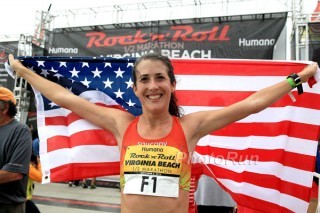
Laura Thweatt won the 2015 Rock 'n' Roll Marathon Virginia Beach Half Marathon on Sept. 6 in 1:12:59. Photo: PhotoRun.net
Laura Thweatt admits she was ready to hang up her spikes, be done with competitive running and move on in life.
After a completing a good but not great college career at the University of Colorado in 2011—she never earned All-American status and never made it to the NCAA track championships like Olympians Kara Goucher, Jenny Simpson, Emma Coburn, Shalaya Kipp and others did before her—she started applying for jobs and graduate school programs.
But, fast-forward four years later, and she’s now she’s among the very elite women distance runners in the U.S. and a serious contender to make the 2016 U.S. Olympic team in the 10,000-meter run next summer.
In the meantime, the 26-year-old Boulder, Colo., resident is running Sunday’s New York City Marathon—her debut at 26.2 miles—and is ready to mix it up with some of the best runners in the world.
So what changed in those four years?
It started with an encouraging friend and a coach confident in her abilities, plus a whole bunch of high school runners who reminded her about the simple joys of running and, of course, her own natural talent and determination.
The friend was former CU teammate Matt Tebo, who was in a similar predicament after finishing his college career; the coach was Lee Troop, head coach of the Boulder Track Club; and the kids were the 120-strong high school runners at Monarch High School, where she has coached since 2011.
“I was applying for jobs, grad school, kind of thinking it was time to transition into the next phase in life,” Thweatt said recently. “When you get out of school and don’t have any sponsorship contracts or opportunities because you haven’t run fast times, you don’t really know how to get to that level.”
Consistent next-level training and Troop’s guidance have helped Thweatt improve every year. Although she didn’t make the U.S. Olympic Trials in the 5,000-meter run in 2012 (with a 15:44 PR), she’s since lowered her time to 15:04 (which ranked third in the U.S. in 2014) and appears poised to lower her 10,000 PR of 32:15 next spring.
She also won the 8K U.S. cross country championships in February, adding to her previous victories at the U.S. club cross country championships in 2013 and 2014. She also got picked up by Saucony with a sponsorship contract.
“I really owe a lot to Matt. He said, ‘you shouldn’t give it up yet. You have a lot to offer and you’ll never know unless you go for it.’ And then training with Lee has made all the difference in the world. It’s pretty cool to see how sticking with it and how little improvements and progressions can make a huge difference.”
But not to be overlooked is her gig as an assistant coach with the Monarch High School program just outside of Boulder. The program has become one of the best in Colorado in recent years under head coach Kent Rieder, with the girls team winning Class 5A state titles in 2011, 2012 and 2013. Although Thweatt will be in New York City, the team returns to the state meet this weekend.
“They know I’ll be there in spirit,” Thweatt said. “It’s amazing to be a part of that program. You can just feel their passion. That’s why they’re out there. They work so hard. They want it.
“I think coaching a high school team has made me a better runner. It gives you a completely different perspective being on the other side of the sport and really helping young kids and getting them going in the sport. I owe those kids a lot too. They definitely got me back into it after I graduated.”
Troop, 42, has transitioned from an elite runner to an elite-level coach after concluding his career that included a 2:09:49 marathon PR and three Olympic appearances for his native Australia. He’s built the Boulder Track Club’s high-performance team with blue-collar athletes who didn’t get sponsorship deals coming out of college but still have potential to improve.
He’s been growing the program from the ground up for about five years. In 2012, he took two athletes to the U.S. Olympic Trials, but next year he could have as many as 10. Other members of the team include former U.S. club cross country champion Jon Grey, who owns a 1:02:35 half-marathon PR, Sean Quigley, who ran 2:13:30 marathon PR last December in Japan and Alex Monroe, who has run 29:42 for 10,000 meters on the track and is hoping to qualify for the 2106 U.S. Olympic Trials Marathon at Saturday’s Rock ‘n’ Roll Philadelphia Half Marathon.
RELATED: Rock ‘n’ Roll Philadelphia To Serve as U.S. Olympic Trials Springboard
Troop also recently bought the Fleet Feet running store in Boulder and hired Thweatt to be his footwear buyer. She works at the store about 20 hours a week, balancing her workouts and strength and recovery sessions.
“Laura is our kind of runner,” Troop said. “When Laura got out of college, she didn’t really have any opportunities and she didn’t know if she wanted to run any more. Frankly, I don’t think a lot of people saw a lot of potential or ability, but I did. I told her, ‘what have you got to lose?’ She’s worked hard to get to where she is now.”
Thweatt was poised to make a breakthrough this past spring and summer after winning the U.S. cross country championships, but a stress reaction in her foot and a banged up knee suffered from a minor car accident sidelined her for the entire track season.
When she got back to training in July, Troop figured the marathon could be a way to build her aerobic base in a fairly low-pressure way. Although she’s qualified for the 2016 U.S. Olympic Trials Marathon, she won’t be running that race on Feb. 13 no matter how Sunday turns out.
“I believe that she’ll be a marathoner eventually, but I don’t want her to do that for another couple of years,” he said. “I’m looking more for her to get the great training metrics and confidence and to have a great racing experience and to do something different and to challenge her. But she’s got plenty of years to run the marathon. The last thing I want to do is throw her into this event and have her burnt out and retire by 28.”
Although she’s potentially the best American in the field and might be capable to run 2:28 or faster in her debut marathon on Sunday, Thweatt said she won’t be wearing a watch. Instead will run by feel, try to race competitively and keep learning what it takes to be an elite runner.
“It takes a lot of patience, a lot of dedication and you have to want it and you have to love it at the same time,” she said. “You have to be willing to sacrifice and put in the hard work day after day regardless of the ups and downs. You have to be able to put your head down and work through it all.”
RELATED: Why I Run: Laura Thweatt
The post Thweatt Eyes Continued Progression in NYC Marathon Debut appeared first on Competitor.com.
Photos: Inside the New York City Marathon Expo

The New York City Marathon expo opened Thursday at the Jacob Javits Convention Center on West 36th Street in Manhattan. We were there to capture the sights as people picked up their bibs and shopped hundreds of booths in the days leading up to the race. (All photos by Steve Godwin.)
RELATED: Special-Edition Shoes for the 2015 New York City Marathon
Photo Gallery
1 of {count}
Back to Start
View Larger Image

View Larger Image

View Larger Image
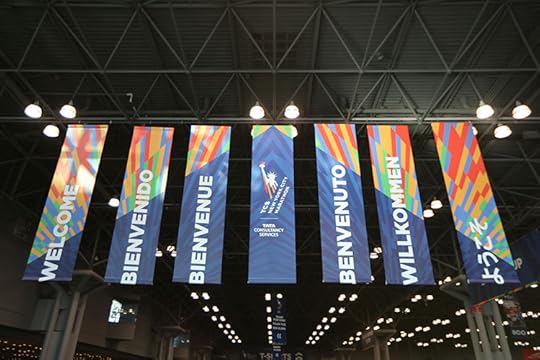
View Larger Image
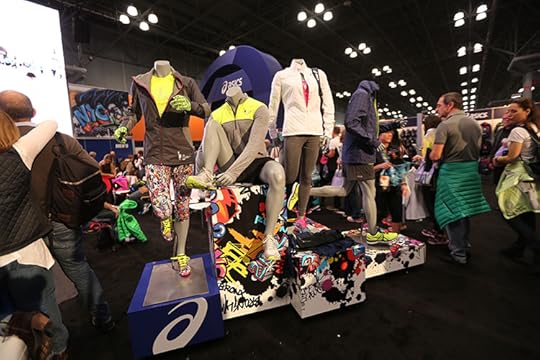
An ASICS display.
View Larger Image

The ASICS shoe area.
View Larger Image

A DJ is working the expo.
View Larger Image

Gatorade Endurance is on hand.
View Larger Image
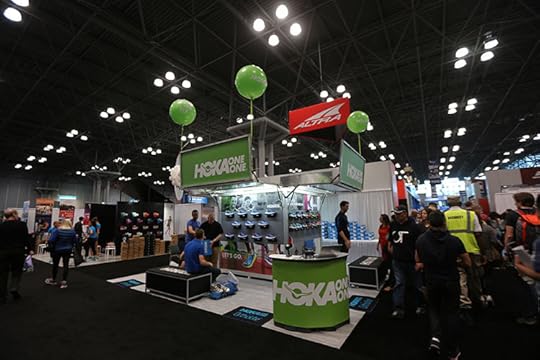
The Hoka One One booth.
View Larger Image
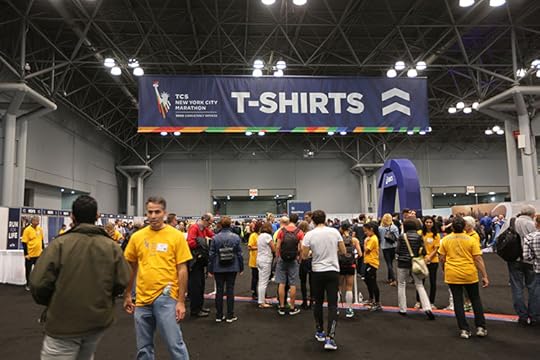
View Larger Image
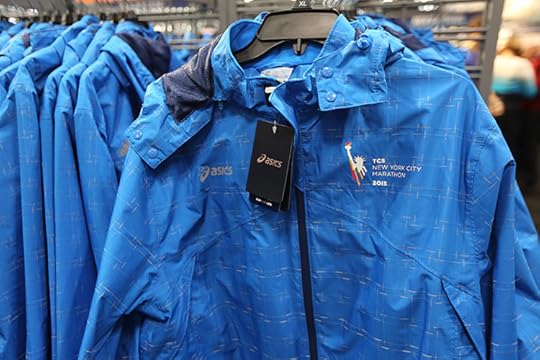
A look at some of the apparel.
View Larger Image
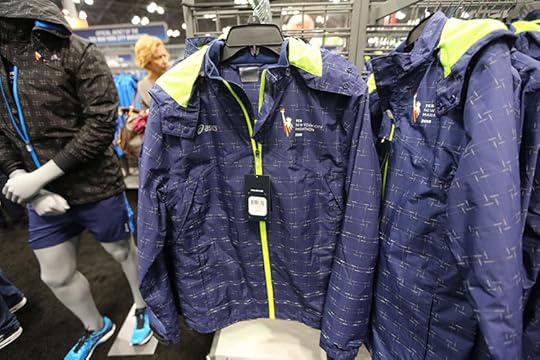
View Larger Image
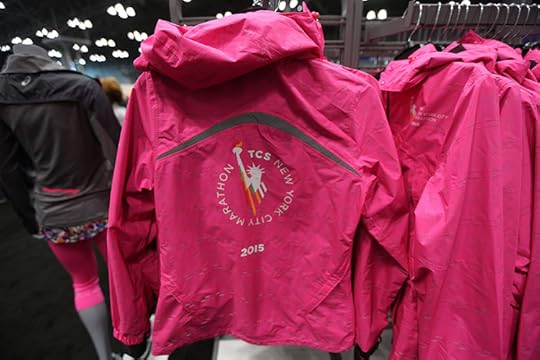
One of the available women's jackets.
View Larger Image
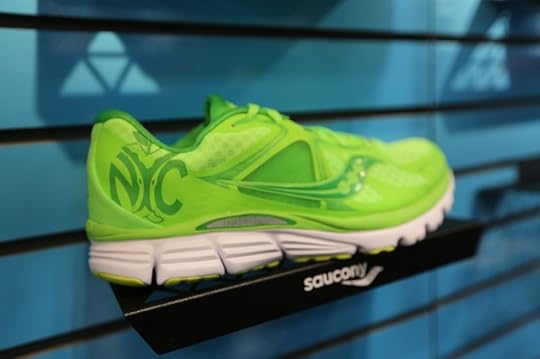
The special-edition Saucony Kinvara 6.
View Larger Image
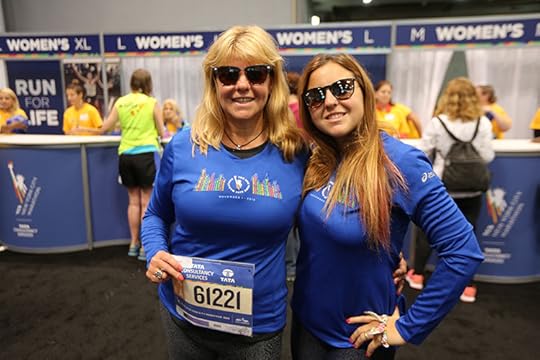
Two runners wearing the participant shirt.
View Larger Image

A close-up of the participant shirt.
View Larger Image

The PowerBar booth.
View Larger Image

Two runners picking up their bibs.
View Larger Image
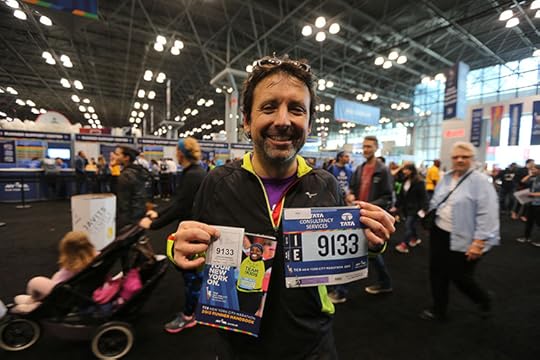
View Larger Image
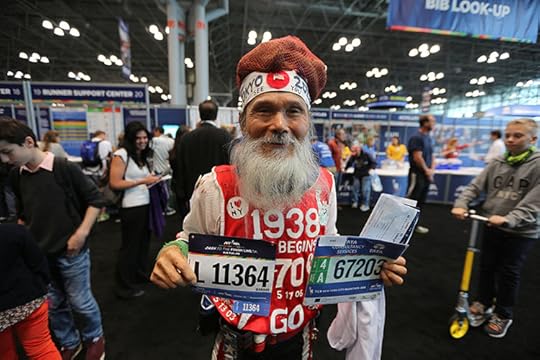
View Larger Image
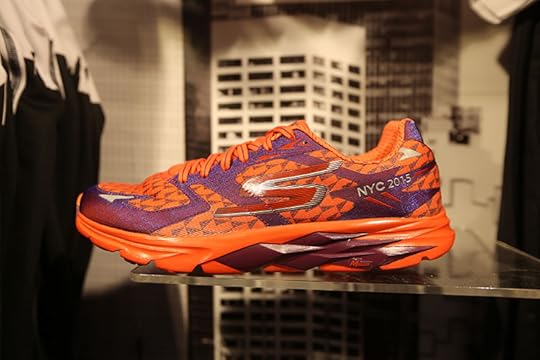
The special-edition Skechers GORun Ride 5.
View Larger Image
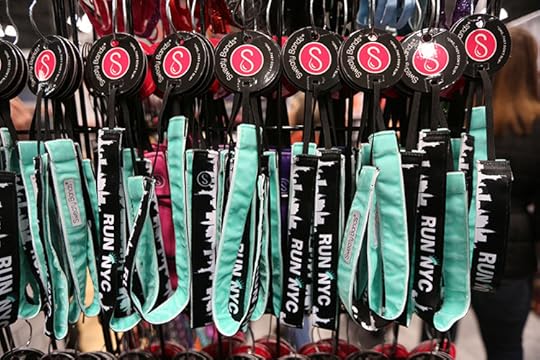
The Sweaty Bands booth.
Related Galleries

Celebrities Running the 2015 New York City Marathon

Sneak Peek: Special-Edition Shoes for the 2015 New York City Marathon

More Galleries
The post Photos: Inside the New York City Marathon Expo appeared first on Competitor.com.
Ryan Hall's Blog
- Ryan Hall's profile
- 21 followers



